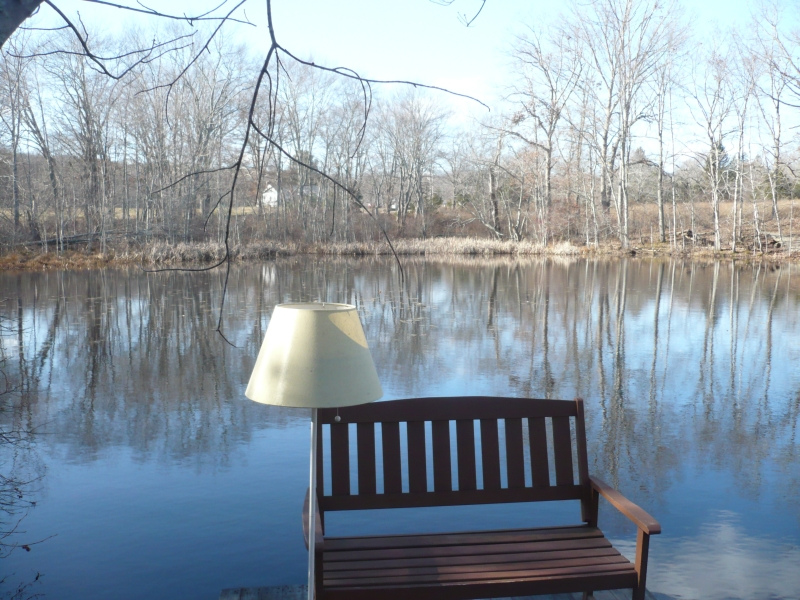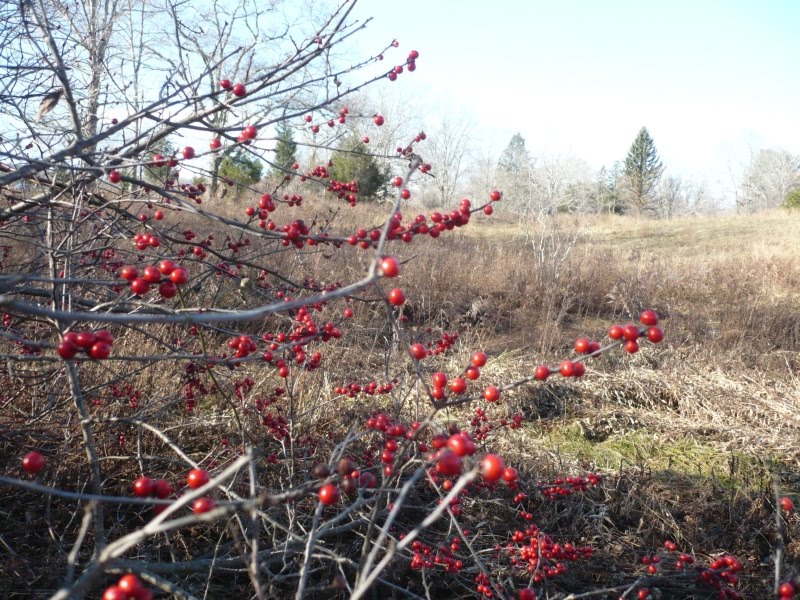In just over a month I will start a one-month residency at I-Park. My proposal is based around 'portable projection', and in this post I want to describe what that means and what I am planning to do onsite.
My proposal to I-Park was that I will appropriate the projection bombing technique (described below), but this time to explore a new approach to my installation work. Instead of scanning, photographing, replicating or manufacturing textures in a studio or gallery, I wanted to work with real, physical objects and textures, which have a life - and unpredictability - of their own.
My proposal is to explore the surfaces and textures of the woodland, by writing software patches which generate 2D geometric shapes, and projecting them as moving video sequences.
The flat plane of the 2D geometric shapes (projected on the flat plane of the 2D projection surface) will be distorted by the underlying natural textures and shapes that the light falls on. In this way, the underlying material will drive the visual artifact in a very direct and immediately perceptible way.
Projection Bombing
When people talk about portable projection they often mean Pico Projectors: very small hand-held projectors with built-in batteries. However these projectors (by nature) are not powerful enough to provide an effective image for bright, realistic video.
The terms 'mobile projection', 'portable projection' and 'projection bombing' therefore also refer to a separate, established technique - that of making a regular, mains-powered video projector portable, by attaching it temporarily to a car battery:
| Example of 'guerrilla' projection bombing, Rio de Janeiro, 2007 |
This approach removes the restriction of position, where a projector can only usually be moved a few meters, or the distance of a power cord. Instead, you need to carry, wheel or drive a car battery around with you to keep the projector powered.
New restrictions
However, with this approach you gain new restrictions. Moving a heavy car battery can be cumbersome, and you can only power the projector this way for a period of 1-2 hours before you need to recharge the car battery - which takes several hours.
The technique is usually associated with a small creative subculture of VJs, street artists and media programmers. It often takes place in an urban context, and has a 'guerrilla' feel - the targeted building surfaces, and projected imagery are often chosen 'on the night', and / or the building owners aren't consulted beforehand.
As with all new techniques ofcourse, media companies have appropriated it to create promotional stunts for their clients. (Compare an original, in 2006 by Karolina Sobecka, with an ad agency version from 2012 inspired by the original).
Textures and surfaces - why projection-bomb in a rural context?
In my previous installation work, I have explored revelation of textural detail:
| Gravity, 2011 |
In 'Gravity', 2011, I was experimenting with the idea of the 'endless plane' which extends beyond the canvass borders. Paintings have long explored this idea, and I was particularly influenced the work of Mark Rothko or Jackson Pollock. Using software and projectors I have been experimenting with the idea that the plane can be slowly revealed, one frame at a time.
Rather than manufacturing a frame, I will be working with found forms and textures on the grounds of I-Park, and temporarily altering the way they are perceived by projecting combined sound and light.
The grounds at I-Park
I-Park is located in a remote, 450-acre woodland with "ponds, hills, streams, stone outcroppings and sheer cliffs" and "wild fields and new growth forest, as well as miles of stonewalls and walking trails". The land "has a wild, gnarly character"... (see the I-Park website).


Jim Sanborn
A good place to get a sense of what this will look like is the work of Jim Sanborn, an American artist and sculptor:
| Lo-res stills from 'The Topographic Projections and Implied Geometries Series', 1995-97 |
(Sanborn is a prolific artist, better known for the sculpture Kryptos, outside the headquarters of the CIA, which contains an encrypted code which to this day has not been fully decrypted.)
For the 'Topographic Projections and Implied Geometries' series, Sanborn used a portable projection technique similar to the one employed in projection bombing, but much more 'planned'. From Sanborn's portfolio:
"These images were produced by direct, large format, light projection. The projector, powered by a mobile generator, was moved from site to site. All of the pieces were photographed at night using long exposures. On moonless nights, the landscape was lit with searchlights. The landforms themselves are quite large, requiring the projector and camera to be, on average, 1/2 mile away from the subject landscape."
Looking at Sanborn's work makes clear a few important questions that I have to consider.
1. The decentred viewer?
Firstly, due to the remote locations, audiences will rarely directly perceive the work. Dissemination relies heavily on documentation, and therefore documentation takes on an importance equal to that of the artwork itself.
This is troubling for an installation artist. Mainly this is because by providing a 'frame' from which to view your work, i.e. a photographic or video frame, you are taking away all other possible perspectives of your work. You are eliminating the 'decentered viewer' as described by Claire Bishop, and you are putting a nail in the coffin of viewer participation too.
However the way I am choosing to look at this is that it is a sequence of short intervention experiments. The end result it may lead to is unknown to me. This may become a performance, it may lead to other directions for installations, or it may be the last portable work that I create. It's hard to say, but that's the nature of experimentation.
2. Differentiation
Since Sanborn's work is aesthetically so similar to that which I am hoping to achieve, it becomes an interesting point of departure. It forces questions about what is the essential nature of my proposal, and the question: What is it that I hope to achieve beyond or seperate from what Sanborn has already achieved?
The first thing to note is that Jim Sanborn's work is beautiful. It is also large-scale, well-funded, and very carefully considered work. What I am planning for I-Park is very ad-hoc and small-scale by comparison.
But putting that aside, there are also conceptual differences. These differences have a lot to do with the influence of digital culture in 2012. But on closer inspection they are also centred around intention, presentation, appearance and dissemination.
Generative sound & video
I will be working with a laptop and a projector. The laptop will run software which will produce video and sound simultaneously. The software will produce those media 'on the fly', which means that unlike Sanborn's work mine will be 'generative' and changeable (and as such, bears the relevant nods to John Cage, Brian Eno, Sol LeWitt, and many others.)
The sound and video will be created together and, ideally, will exist as a single entity. Data from the one will feed the other, as in the work of Memo Akten:
| Simple Harmonic Motion study #5d by Memo Akten |
Where Akten's work is purely pattern-based, I will introduce a certain amount of randomness. This is very much intentional. Each evening I want to go out and perform a short (1-2hr) experiment, allowing patterns to generate and run.
The next day I want to try a new pattern, software patch or set of geometries, influenced by the previous evening's work, but never fully take control. There is a fast turnaround and each installation will be fleeting, but each installation will also be surprising, since it will not be defined upfront.
Borders & masking
Where Sanborn allows the natural borders of his patterns to be exposed, I intend to 'mask' my projections in the 'projection mapping' style:
| Projections mapped over vines |
The main reason for this is that Sanborn used either moonlight, or search lights to expose the non-projected areas. This makes sense with long-exposure photographs but moonlight will not make a difference to video. This is potentially an area to be explored.
Another difference which may exist (I will find out when I do it) is that my work may expose a little more of the technological mechanisms which produce it. This isn't necessarily by design, but with a lower budget and a car battery rather than a generator, the projector used at certain angles may show pixels, or differences in brightness over extended distances, or other artifacts that I haven't thought of yet. This isn't my intention, but it will be interesting to see what effect this might have.
The purpose of documentation
In Sanborn's work, the time dimension is noticable. The long exposures mean that stars in the night sky are captured moving from position to position, which gives a subtle but powerful sense that these are not just 'recordings' of events, but are events mixed with recording techniques.
It's hard to see where the recorded event ends and the recording technique begins. They are fully intertwined, since the represented event in the documented image was never really experienced by a human in quite the way it is presented.
With my work at I-Park, the recorded documentation will be in video form. The role of the video will be to demonstrate the installation as recorded from a particular angle, as faithfully as possible. The primary focus of my work will be the live event, and the video recording will be an attempt only to reproduce that event for dissemination, not to become part of the work as such in itself.
However although that's the intention, inevitably the recorded events will become a lens through which the work is viewed, and therefore can't fail to have a big impact on it's perception. But as discussed above the future of the work is open-ended - it was concieved as installation and as a work for direct perception by audiences, but the emphasis may change depending on the results.
Dissemination
I want to publish the work online as I go, week by week. This means I have the potential to get external feedback as the process develops, rather than after delivering the work at the end in a gallery or presentational setting. I'm viewing this residency as an open-ended experiment.
With that in mind, it makes sense to try to initiate a group of interested individuals before I start, designers, software developers, artists, who might be interested in commenting on the experiments.
I'm looking forward to starting the experiments, and will be posting more info about the preparation work I'm doing over the coming weeks.